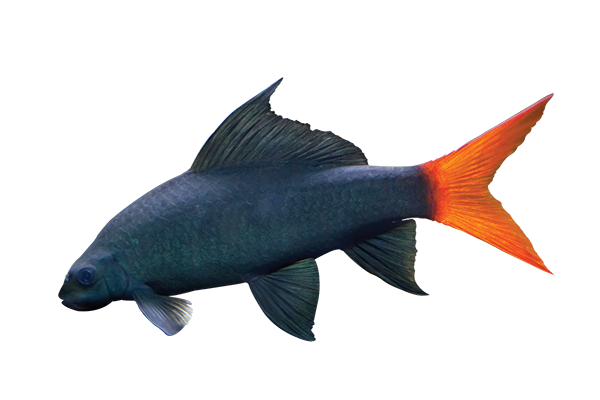Freshwater Sharks
Imposters
While not true sharks, this group of freshwater fish – many of which are from the Family Cyprinidae – have a strong resemblance to their ocean-going counterparts, only in miniature form. Their characteristic torpedo-shaped bodies and high dorsal fins give them a decided "shark-like" look, and their active swimming behavior and sometimes feisty personalities complete the package.
Shark Fish Type Relation
Bala, Redtail, Rainbow, Harlequin, and Black Shark Barbs, Goldfish, Koi
Red Streak and Red-finned Cigar Shark Barbs, Goldfish, Koi
Hi-fin Bull and Iridescent Shark Catfish
Freshwater sharks are native to Southeast Asia, China, Africa and Central America, however most specimens sold today are produced on commercial fish farms. Albino varieties of several species have become available through selective breeding.
A Freshwater Shark's Natural Habitat
Most freshwater sharks occur in large river systems in the wild. Hi-fin bull sharks, also known as Colombian sharks, are catfish that occur in rivers, brackish water estuaries and even in the ocean along the Pacific Coast of Central America and Northwestern South America. Freshwater shark populations are dwindling in nature, particularly in Southeast Asia, due to dam building and the disappearance of breeding areas as a result of development.
Water Requirements for Freshwater Sharks
Freshwater sharks tolerate a wide range of water quality parameters in the aquarium. For best results, pH should be between 6.8 and 8.0, with hardness between 2° and 10° dKH (35 to 175 ppm). Colombian or hi-fin sharks prefer slightly higher pH and alkalinity and benefit from the addition of up to 1 tablespoon of aquarium or sea salt per gallon. Before adding salt to any aquarium, make sure other inhabitants are tolerant of it! Temperature for most sharks should be 74° to 80° F. The exception is the Chinese banded shark, which can be kept at temperatures as low as 60° F. Use an Aqueon Aquarium Heater to maintain the correct temperature. Maintain good filtration and do a 10% water exchange every week or 25% every 2 weeks using an Aqueon Aquarium Water Changer or Siphon Vacuum Gravel Cleaner. Don't forget to treat tap water with Aqueon Water Conditioner before refilling your aquarium!
Housing Requirements for Freshwater Sharks
Red tail and rainbow sharks become territorial as they grow and should be provided with plenty of space as well as caves and other structures to call "home". Others, like bala, black, harlequin and Colombian sharks can reach over 12" in length and will require an aquarium of at least 100 gallons when full grown. It should be pointed out that Chinese banded and red-finned cigar sharks can achieve 36", and iridescent sharks exceed 48" in nature. These fish should not be kept in home aquariums. (The notion that fish grow to the size of their habitat is false.) Most freshwater sharks are accomplished jumpers, so keep a secure lid on the aquarium.
Freshwater Sharks Behavior/Compatibility
Red tail and rainbow sharks become territorial, especially toward one another and are best kept individually when they get older. Tank mates should be robust and include active fish like giant danios, silver dollars, tinfoil barbs, medium sized non-aggressive cichlids, larger loaches and large gouramis. They will patrol the entrance to their lair and chase intruders away. Thai flying foxes (Crossocheilus spp.) and bala sharks (Balantiocheilos melanopterus) are more peaceful and can be kept with community fish that are similar in size. Thai flying foxes make excellent scavengers and are useful for controlling string or hair algae. Always consult an aquarium expert before adding any new fish to your aquarium.
What Do Freshwater Sharks Eat?
You can tell a lot about a fish's diet by looking at its mouth parts. Sharks with sucker-type mouths typically rasp algae off rocks and submerged wood, and feed on plants, as well. Other foods include aquatic invertebrates, worms and small fish. Iridescent and Colombian sharks, with their wide cavernous mouths, are predatory and will not hesitate to eat small fish and/or shrimp. Most sharks are omnivorous in captivity and will thrive on a varied diet that includes Aqueon Tropical Flakes, Color Flakes, Spirulina Flakes, Tropical Granules, Algae Rounds, Bottom Feeder Tablets and Shrimp Pellets. Frozen and live foods can also be fed as treats to improve growth and color. For best results, rotate your fish's diet daily and feed only what they can consume in 2 to 3 minutes, once or twice a day.
Freshwater Sharks Breeding Level – Difficult
Very few records of freshwater shark breeding in home aquariums have been reported. Commercial breeders often use hormones to induce spawning of redtail, rainbow and bala sharks.


